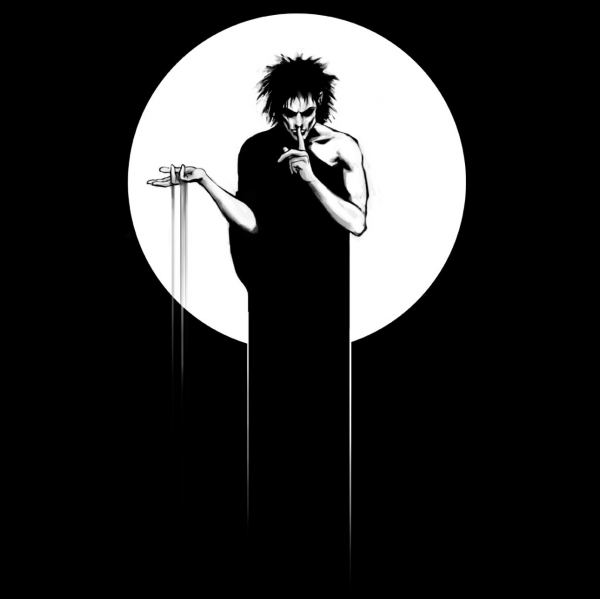Confessor
CCF Mod Squad
Not Bucky O'Hare!
Posts: 10,974 
|
Post by Confessor on Dec 2, 2019 14:45:29 GMT -5
So, back in August I began reading Neil Gaiman's landmark comic series The Sandman. It was a series that I had wanted to read for a long, long time...mostly due to things people here at the CCF had said about it over the years. But also, a comic reading buddy of mine, whose taste I trust implicitly, once told me that it was the best comic series he'd ever read. High praise indeed! Initially, I started posting what were only supposed to be short, pocket reviews for each trade paperback over in the "What classic comics have you read lately?" thread. But these reviews ended up being much longer than I had intended, and, as a result, I began to regret not starting a dedicated review thread for the series. But then again, I guess I didn't know if I'd enjoy reading it enough to finish the series when I started it. I have now read the first 5 volumes and I am definitely hooked. So, I've decided to expand further on the short reviews I had previously posted, add some pictures to them, and turn them into a dedicated Sandman review thread. Under normal circumstances, I would have reviewed this series issue-by-issue, as I did with my Star Wars review thread, but since the TPBs were the format that I encountered The Sandman in (and which I continue to buy) – and since Slam_Bradley tells me that The Sandman was one of the first comics that really took off in collected editions – it kinda makes sense to review the series like this, I think. I will be reviewing all 10 TPB volumes, collecting the main 75 issue Vertigo Comics run. After that, I may be tempted to delve deeper into some of the spin-off series and other additional volumes, but we'll see. I make no promises other than reviewing the first 10 collected editions. I'm hoping to learn a lot from fans here, so please feel free to chime in with your own contributions, expand upon my points, disagree with what I write, or offer alternative thoughts and interpretations to the opinions in my reviews. Shortcuts to reviews of the main volumes:• Volume 1: Preludes & Nocturnes• Volume 2: The Doll's House• Volume 3: Dream Country• Volume 4: Season of Mists• Volume 5: A Game of You• Volume 6: Fables & Reflections• Volume 7: Brief Lives• Volume 8: Worlds' End• Volume 9: The Kindly Ones• Volume 10: The WakeSupplementary reviews:• Death: The High Cost of Living• Death: The Time of Your Life |
|
Confessor
CCF Mod Squad
Not Bucky O'Hare!
Posts: 10,974 
|
Post by Confessor on Dec 2, 2019 14:46:04 GMT -5
The Sandman: Volume 1 – Preludes & NocturnesOriginal publication: The Sandman #1–8 (January 1989 – August 1989) Script: Neil Gaiman Artwork: Sam Kieth (pencils)/Mike Dringenberg (pencils & inks)/Malcolm Jones III (inks) 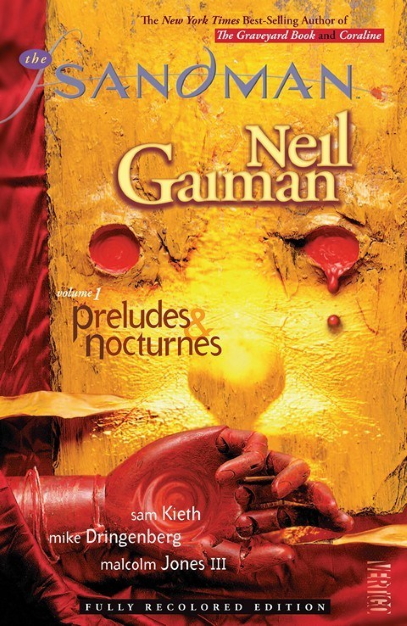 Publisher's synopsis Publisher's synopsis: In PRELUDES & NOCTURNES, an occultist attempting to capture Death to bargain for eternal life traps her younger brother Dream instead. After his 70 year imprisonment and eventual escape, Dream, also known as Morpheus, goes on a quest for his lost objects of power. On his arduous journey Morpheus encounters Lucifer, John Constantine, and an all-powerful madman.
This book also includes the story "The Sound of Her Wings," which introduces us to the pragmatic and perky goth girl Death.So, here we go then. The first volume of The Sandman, "Preludes & Nocturnes".  As I understand it (and feel free to correct me if I'm wrong), Neil Gaiman's original idea for The Sandman was to revisit the characters of Jack Kirby's 1970s Sandman series. DC Editor (and future Vertigo mastermind) Karen Berger suggested that instead he retain the name of "Sandman", but essentially create an entirely new series. Gaiman took some ideas that he had already come up with about a character who lived inside people's dreams, and turned that into Morpheus (a.k.a. Dream), who is both the mythical Sandman of folklore and the literal personification of dreams themselves. Gaiman also decided to re-introduce a handful of obscure characters from DC's old horror comics to populate the realm of "The Dreaming" with. Myself, I'm reading the 2010 editions of these TPBs, which feature the Gaiman-sanctioned re-colouring that first appeared in the Absolute Sandman volumes. Before starting the series, I gave quite a lot of thought to which versions of the books I wanted to pick up because usually I'm a real stickler for original colouring in reprints. However, having compared the old colouring and the "Absolute" re-colouring online, I came to the conclusion that, although the original colouring had a certain old-skool charm and a "surreal" or "otherworldly" quality to it, the re-colouring made the artwork "pop" much more and also served the story better. Your mileage may vary, and I'd certainly be interested to hear folks' opinions on the re-colouring job. Here's a comparison of the two colouring variations: re-colouring on the left, original colours on the right... 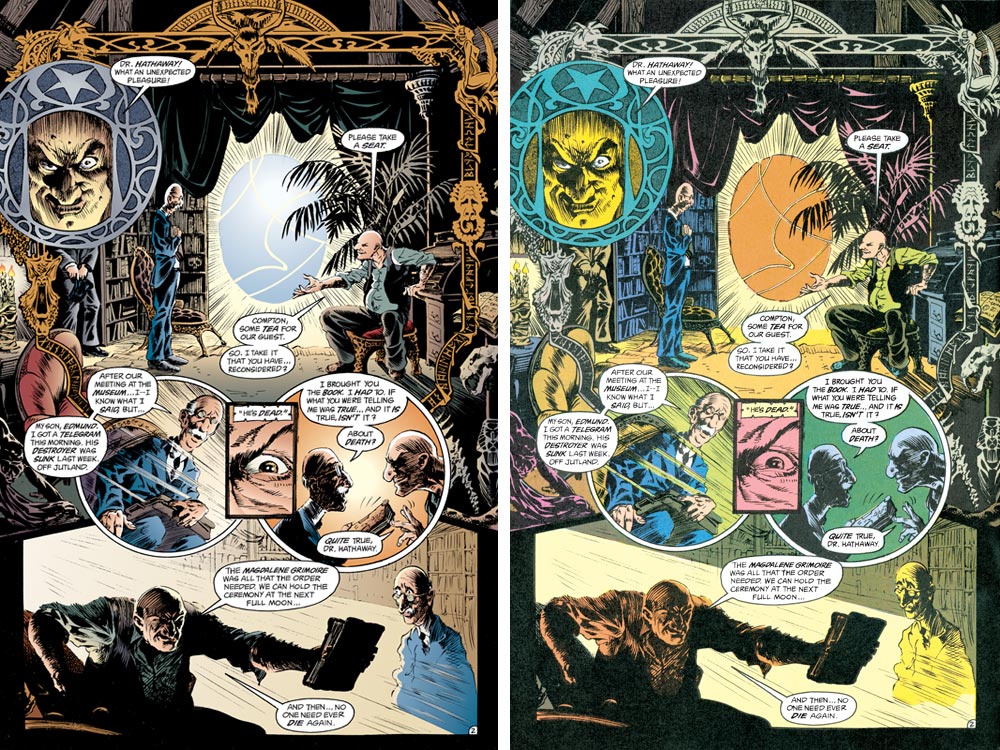 Moving onto the contents of "Preludes & Nocturnes", the very first chapter/issue is a real corker! It does an excellent job of introducing the core characters and concepts of The Sandman in a very gripping and entertaining way. The story begins in 1916, with the occultist Roderick Burgess undertaking an arcane magic ritual in order capture the embodiment of Death, as a means of achieving immortality. Unfortunately, the ritual doesn't quite work properly and he instead traps Death's younger brother, Dream. As a result of this, people the world over begin to fall asleep for years. The Alistair Crowley-style occult vibes are very strong in this first chapter, and it certainly hooked me into the story and made me desperate to get into issue #2 to find out what was going to happen. Morpheus bides his time as a prisoner for 72 years, and – in a little touch that I really liked – the universe attempts to fill the vacuum created by his disappearance, which Gaiman offers up as the reason why Wesley Dodds became the gas gun-wielding DC hero, Sandman, in the 1930s. Of course, Morpheus does eventually escape from his occult prison and begins a quest to recover the magical belongings that Burgess stole from him (a bag of "dreaming sand", a helmet, and a ruby). The pouch of sand is located with the former girlfriend of John Constantine, of Swamp-Thing and Hellblazer fame, while the ruby is found with Doctor Destiny (a DC supervillain), who has escaped from Gotham City's Arkham Alyssum. Dream has to journey to Hell and meet with Lucifer in order to retrieve his helmet, and, while he's there, he runs into an old lover named Nada, who we shall learn more of in later volumes. The encounters I've described above give a good indication of how The Sandman likes to delve into the far corners of the DC Universe. As I've read a little further into the series, I've come to realise that Gaiman is setting up a lot of stuff in "Preludes & Nocturnes" that will tie directly into later volumes. However, one minor criticism relating to this is that, at points, this first volume becomes so chock-full of rapidly introduced characters and ideas – which Gaiman doesn't particularly bother to expound upon in this volume – that it can be a slightly frustrating read for a newcomer. On the artwork front, Sam Kieth's pencils in the early part of the book are really nice. His art is kind of scratchy and "unkempt" in places, but that style definitely serves the eerie, occult-heavy narrative of this section of the book very well. I also really like the expressiveness of his characters' faces. Oh, and I love his design for Morpheus's helmet... 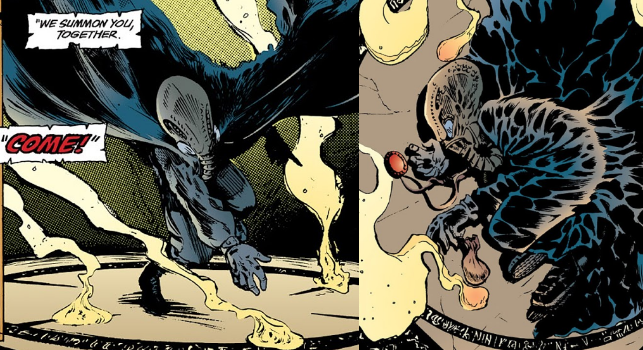 Also, this double-page splash by Kieth and inker Mike Dringenberg of Morpheus and Lucifer surveying the assembled demon hordes of hell is fantastic... 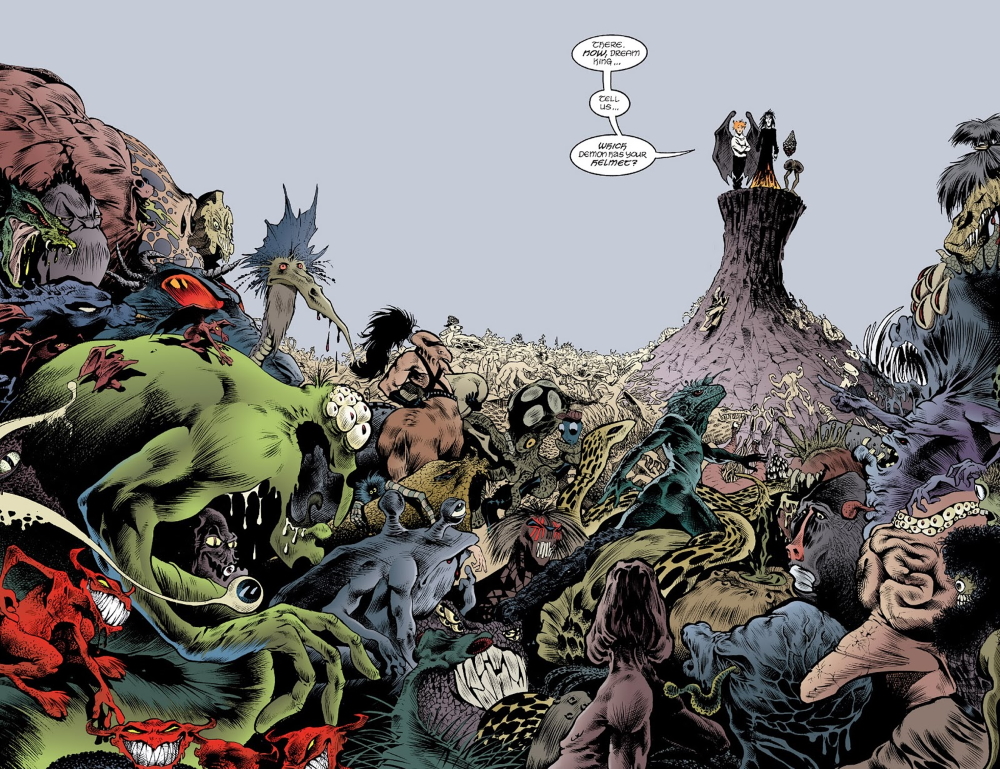 After inking issues #1 and #2, Dringenberg begins pencilling the series (initially with Kieth) from issue #3 onwards. His artwork is a little slicker looking than Kieth's, and I particularly like the level of detail he puts into his work. I would also say that Kieth and Dringenberg's depiction of Hell is one of the most disturbingly grotesque – and therefore most convincing (at least, most convincing based on how I envisage Hell) – that I've ever seen...in comics or any other medium... 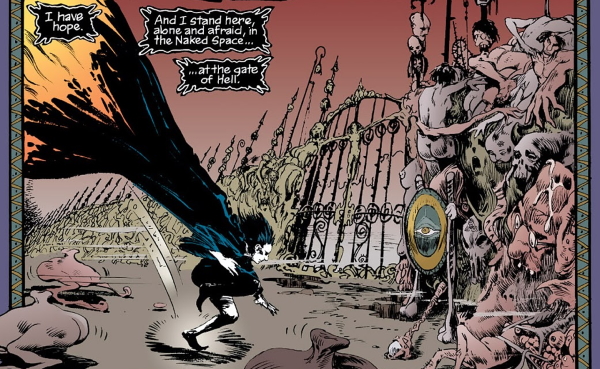 I found the second chapter/issue of The Sandman to be slightly less intriguing than the first, but it nevertheless fleshed the story out quite a bit and was still an enjoyable read. However, as the issues from #2 to #6 roll by, it also kinda seems as if Gaiman is just throwing all sorts of different stuff at the wall to see what sticks. For example, the use of Cain and Able – the two goofy hosts from DC's old House of Mystery and House of Secrets comics – is cute, but it also seems really out of whack with the mystical/horror ambience that Gaiman had established earlier. 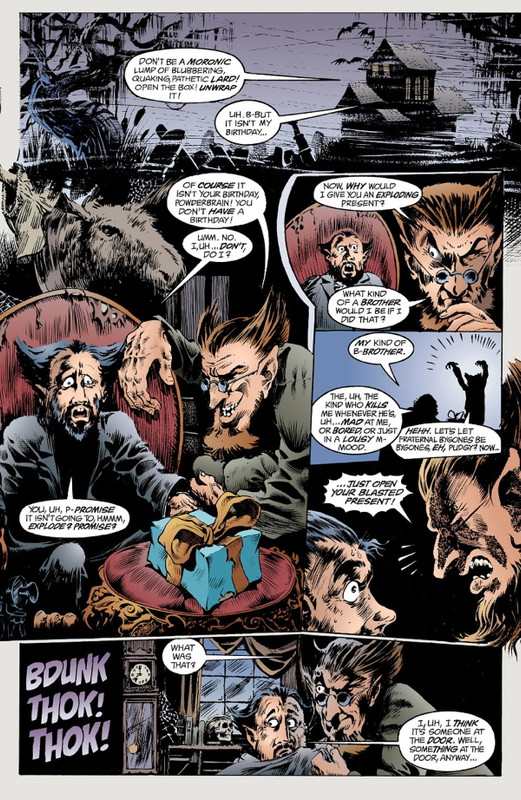 We also get an appearance of the three witches Cynthia, Mordred, and Mildred from DC's The Witching Hour comic, and just as with Cain and Able, I could've done without that. I also didn't think much of the overly gory chapter involving Doctor Destiny sitting in a diner. I felt that it unfortunately read like a lot of other "for mature readers" comics from the 1990s, with some rather immature "oh-so-gritty" violence and mutilations randomly thrown in for no good reason. This chapter in particular made "Preludes & Nocturnes" seem more like what a 15-year-old boy would think of as mature writing, as opposed to what mature writing really is – something that a lot of 1990s "for mature readers" books suffer from, IMHO. On a more positive note, I really liked the book's central protagonist, Dream (or Morpheus), a lot. He looks suitably otherworldly – as the lord and personification of dreaming should – with an attendant air of wisdom and gravitas to him. He also cuts a rather lonely and slightly tragic figure at times... 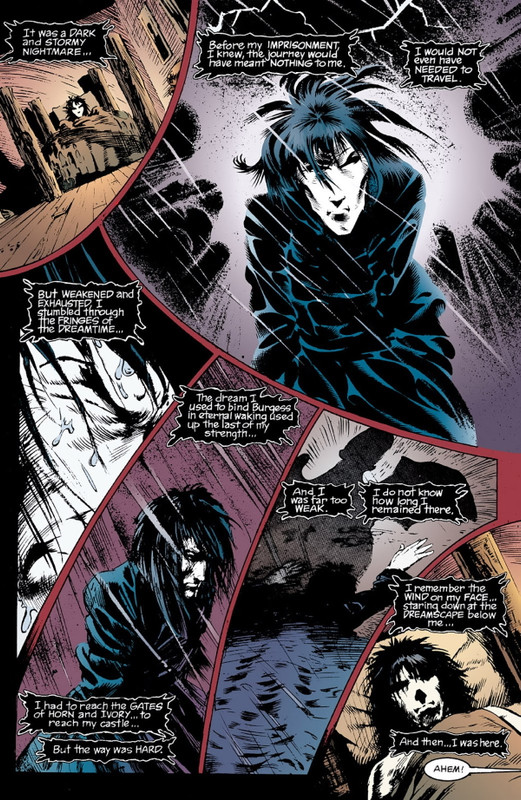 While it might only be a small thing, I think it's worth noting that "Preludes & Nocturnes" is not your usual comic book fare. What I mean by that is that it's not the usual story of a mortal who is given God-like powers and/or travels to alien worlds or other dimensions; it is the story of a God-like being from another dimension, who is sucked into our mundane world, stripped of his powers, and then left to find his way back home. That's not to say that this is a wholly original concept, of course, but its different enough from most of what DC had published prior to this point that it's probably worth mentioning. Morpheus's sister, Death, makes her first appearance in the final chapter, "The Sound of Her Wings", and, for me, this is the point where the The Sandman redeems itself for those earlier missteps and hits the heights that I was expecting from it. I initially had misgivings about the way Death looked. I mean, depicting her as a cute teenage goth chick might've seemed edgy to young readers in 1989, but reading this as a 40-something man in 2019 just induced severe eye-rolling from me...  However, this final chapter of "Preludes & Nocturnes" is so masterfully written and so beautifully rendered artistically, that I actually found myself being quite moved by it -- which is a rarity for me when it comes to comics! Though the chapter is mostly concerned with death, its an uplifting, rather than a depressing read...and a bit of a tear-jerker too. By the time "The Sound of Her Wings" had worked its magic on me, Death felt like my new favourite comic character and my earlier misgivings about her appearance were rendered utterly irrelevant. So yeah, overall, I found this first volume of The Sandman to be rather hit and miss. But that's OK because I was kinda prepared for that, since I'd heard that the series takes a few volumes to really get going. Of course, with that said, parts of "Preludes & Nocturnes" are excellent, with Gaiman's writing being almost up to Alan Moore's standards (which, coming from me, is high praise indeed). I'm definitely looking forward to moving on to volume two, "The Doll's House".
|
|
Confessor
CCF Mod Squad
Not Bucky O'Hare!
Posts: 10,974 
|
Post by Confessor on Dec 2, 2019 14:52:08 GMT -5
OLD REPLIES TO VOLUME 1:Here, just for the sake of completeness, are the replies that various members of the forum posted in response to my original, short review of "Preludes & Nocturnes", over in the "What classic comics have you read lately?" thread... On August 22nd, 2019 Slam_Bradley wrote: --------------------------------------------- On November 24th, 2019 berkley wrote: To which I replied... While bor replied to berkley with this... And @mrp replied to berkley with this...
|
|
|
|
Post by Calidore on Dec 2, 2019 20:13:28 GMT -5
Great series that holds up well on rereads. I Ebayed about 2/3 of my collection many years ago, but this series easily made the cut.
If you're interested in checking out the original, non-powered Sandman and like quality noir, I can highly recommend Sandman Mystery Theatre.
|
|
Confessor
CCF Mod Squad
Not Bucky O'Hare!
Posts: 10,974 
|
Post by Confessor on Dec 2, 2019 20:31:32 GMT -5
If you're interested in checking out the original, non-powered Sandman and like quality noir, I can highly recommend Sandman Mystery Theatre. I actually read the first TPB of Sandman Mystery Theatre about 10 years or so ago, when I got it out of my local library. I remember enjoying it a whole lot, although my memory of exactly what happened in that first collected volume is a little hazy. SMT is one of those series that I always vaguly planned to read more of, but never did. On a related note, I was wondering whether the launch of SMT in the early '90s was triggered by the success of Gaiman's The Sandman and Wesley Dodds' connection to that series, as outlined in his brief appearance in "Preludes & Nocturnes"? |
|
|
|
Post by badwolf on Dec 2, 2019 21:58:04 GMT -5
I love the diner issue, but I guess if you're not a horror fan it might not be as appealing. I found it quite disturbing and one of the most memorable stories of the entire series.
I have mixed feelings about the recoloring. I, too, am a purist and tend to want the books as they originally appeared (especially since that was how I read them the first time(s).) I like the old school and "comic book" look (nothing wrong with that) of it. The new coloring is nice, and would be totally fine if that was the only way it had been done, but...........I don't know. Some pages could use the improved coloring, others are not necessarily helped by it. In the example above, I really do prefer the original.
|
|
Confessor
CCF Mod Squad
Not Bucky O'Hare!
Posts: 10,974 
|
Post by Confessor on Dec 3, 2019 0:18:01 GMT -5
I love the diner issue, but I guess if you're not a horror fan it might not be as appealing. I found it quite disturbing and one of the most memorable stories of the entire series. It wasn't the gore or the horrific nature of this part that turned me off, it was the fact that it felt a little too "slasher movie" or something. Like Gaiman was trying a little too hard to be edgy, almost just for the sake of it. I dunno, it just felt a little forced to me and not in keeping with the atmosphere of the rest of this opening arc. I have mixed feelings about the recoloring. I, too, am a purist and tend to want the books as they originally appeared (especially since that was how I read them the first time(s).) I like the old school and "comic book" look (nothing wrong with that) of it. The new coloring is nice, and would be totally fine if that was the only way it had been done, but...........I don't know. Some pages could use the improved coloring, others are not necessarily helped by it. In the example above, I really do prefer the original. Yeah, I hear you on the re-colouring. It's not like I dislike the original colouring at all...in fact, I rather like its more fantasy-inspired palette a fair bit. But, to my eyes, the more naturalistic re-colouring fits the story better and adds a sense of heightened "realism" to the series overall. |
|
|
|
Post by codystarbuck on Dec 3, 2019 0:43:06 GMT -5
I saw the first issue when it came out; but, it was a bit too out there, for my tastes, at the time. I liked Sam Kieth, but, I'm not a horror guy; so, I moved on. I next looked at it when the Sandman Special came out, with the wedding of Orpheus. That was it until the first two trade volumes were released. Enough time had passed that Gaiman was in the middle of an arc; so, I waited for the finish of it to start reading the series, which was issue 50 and the World's end storyline. I used the trades to read the earlier material. I came to appreciate Gaiman's take on things, especially his use of language, in telling his stories.
If I'm not mistaken, Gaiman actually designed Morpheus and the helmet and Kieth embellished upon it. Ironically, there was a similar gas mask/helmet that would appear in the European supernatural series Rork, by Andreas and I wondered if that had possibly been a visual influence on Gaiman.
There is a bigger attempt at connecting the series to the DC universe in that first volume, with Cain & Ael et al and I think that is understandable, as it helps pull in existing DC readers and makes this new concept a bit familiar. Cain develops a bit as things go, though he is not a huge part of the series.
I've read horror comics before; but, Sandman was one of the first to really creep me out, with the next volume; and, the later Game of You.
Death was an inspired character, though I have always felt the way she is handled owed much to Gaiman's later collaborator, Terry Pratchett. The difference is that Pratchett's DEATH is often trying to understand humanity, while Gaiman's is fully versed and revels in it. He expands upon her in the Death mini-series.
I grew to be a huge fan and this series has a special place for me, on a personal level. I had a good friend and co-worker, named Jason, who worked with me at Barnes & Noble. he was also a comic fan and was a huge Gaiman fan. We could talk for hours about Gaiman's writing. Jason was the nicest person you could ever meet; soft spoken, extremely polite, and just a gentle soul. His marriage fell apart because he was too nice and gentle and his wife wanted someone else. However, fate brought his true love into our store and thrust them together. They would marry and have a son and move elsewhere. Jason started having problems with the feeling in his arm and thought he had a pinched nerve and went to get it checked out. It wasn't a pinched nerve; it was renal cancer and it had spread throughout his body, causing pressure on the nerves in his arm. Chemo was tried; but failed. He passed away within a year of diagnosis, leaving behind his wife and a son who worshipped his dad. We had a memorial service for him at a park, and the program for the service had quotes from Sandman, including my favorite, which I always recall, when dealing with death....
"You got what everyone gets; you got a lifetime."
That simple phrase and the thought behind it helped me through the loss of my friend and the loss of my father, that same year; not to mention the loss of my mother just a couple of months ago.
Gaiman is truly a literary Marvel and Sandman is where he first demonstrated it. This first volume is a bit rough, in spots, as Gaiman works out the dynamics of things; but, there are so many moments of brilliance that the weak parts fade into the background.
Sandman Mystery Theater was related to the success of Gaiman's Sandman and Matt Wagner had the hook for it, to mix the dreamlike world of Gaiman's stories with the pulp traditions of Wesley Dodds. It was a kind of Vertigo pulp series, mixing influences from The Shadow and The Spider, with the Golden Age hero and contemporaries, plus great mystery writers. Wagner really developed the relationship between Wesley dodds and Dian Belmont, make them a sort of Nick and Nora Charles of the Mystery Men set.
|
|
Confessor
CCF Mod Squad
Not Bucky O'Hare!
Posts: 10,974 
|
Post by Confessor on Dec 3, 2019 9:15:40 GMT -5
If I'm not mistaken, Gaiman actually designed Morpheus and the helmet and Kieth embellished upon it. Ah, OK...good info. This is exactly the kind of background knowledge that I was hoping to learn from doing this thread.  There is a bigger attempt at connecting the series to the DC universe in that first volume, with Cain & Ael et al and I think that is understandable, as it helps pull in existing DC readers and makes this new concept a bit familiar. Yeah, Gaiman putting long-unused or half-forgotten DC characters into the series certainly makes sense from a marketing point of view or as a way to hook existing DC Comics fans. But it also seems entirely counter to the shadowy occult/mystery or literate metaphysical storylines that are the series' strongest elements in the beginning, and I just wish he wouldn't do it. Having read up to volume 5 so far, I'm pleased to find that these appearances by obscure DC Comics' characters are reduced a fair bit as Gaiman hits his stride and establishes the tone of the series. Death was an inspired character, though I have always felt the way she is handled owed much to Gaiman's later collaborator, Terry Pratchett. The difference is that Pratchett's DEATH is often trying to understand humanity, while Gaiman's is fully versed and revels in it. He expands upon her in the Death mini-series. I grew to be a huge fan and this series has a special place for me, on a personal level. I had a good friend and co-worker, named Jason, who worked with me at Barnes & Noble. he was also a comic fan and was a huge Gaiman fan. We could talk for hours about Gaiman's writing. Jason was the nicest person you could ever meet; soft spoken, extremely polite, and just a gentle soul. His marriage fell apart because he was too nice and gentle and his wife wanted someone else. However, fate brought his true love into our store and thrust them together. They would marry and have a son and move elsewhere. Jason started having problems with the feeling in his arm and thought he had a pinched nerve and went to get it checked out. It wasn't a pinched nerve; it was renal cancer and it had spread throughout his body, causing pressure on the nerves in his arm. Chemo was tried; but failed. He passed away within a year of diagnosis, leaving behind his wife and a son who worshipped his dad. We had a memorial service for him at a park, and the program for the service had quotes from Sandman, including my favorite, which I always recall, when dealing with death.... "You got what everyone gets; you got a lifetime." That simple phrase and the thought behind it helped me through the loss of my friend and the loss of my father, that same year; not to mention the loss of my mother just a couple of months ago. Beautiful story, cody, and I agree...Gaiman is quite the master of words.
This first volume is a bit rough, in spots, as Gaiman works out the dynamics of things; but, there are so many moments of brilliance that the weak parts fade into the background. Yeah, in a nutshell, this is how I felt about "Preludes & Nocturnes". Moments of utter brilliance and moments of ill-fitting, half-formed ideas that don't quite click. Still, this was very early days for the series.
Sandman Mystery Theater was related to the success of Gaiman's Sandman and Matt Wagner had the hook for it, to mix the dreamlike world of Gaiman's stories with the pulp traditions of Wesley Dodds. It was a kind of Vertigo pulp series, mixing influences from The Shadow and The Spider, with the Golden Age hero and contemporaries, plus great mystery writers. Wagner really developed the relationship between Wesley dodds and Dian Belmont, make them a sort of Nick and Nora Charles of the Mystery Men set. I suspected as much, insofar as it was Gaiman's Sandman that kick-started the Sandman Mystery Theatre series. As I said above, I have read the first volume of SMT, but I never read any further than that. I really must do, one of these days. |
|
|
|
Post by badwolf on Dec 3, 2019 11:10:11 GMT -5
I had a few issues of SMT (the first two arcs I think) but I wasn't really into it at the time. However I think I'd really like it now. Have to pick up one of the collections sometime.
|
|
|
|
Post by beccabear67 on Dec 3, 2019 14:05:16 GMT -5
I've read Gaiman in text form, and seen some tv based on his writing, but the look of this comic always struck me as way too trendy, a very superficial element for me to judge by I know, and especially when the Lady Death character was plastered all over the place it equally repelled me, not scared, more like 'oh, come on'. I guess it attracted a lot of punters though as they say, and I can well imagine the writing being high quality. Maybe someday. I am a horror fan actually, have the original Mary Shelley on the shelf and lots more besides (Poe, Robert W. Chambers, Lovecraft etc.), volumes into the old Dark Shadows U.S. soap, and I'm even pretty pallid much of the year, plus I treasure the music of Joy Division and The Velvet Underground most sincerely (so maybe you have to be big on the Cure and The Cult instead?), it's just the LeStat onward style of sexy dead characters with the white skin thing... not folks I wanna hang around? The 'What We Do In The Dark' tv series is a pleasure for me as it punctures so much of that style. I will try to follow and appreciate this review however, vicariously.
|
|
Confessor
CCF Mod Squad
Not Bucky O'Hare!
Posts: 10,974 
|
Post by Confessor on Dec 3, 2019 14:37:16 GMT -5
I've read Gaiman in text form, and seen some tv based on his writing, but the look of this comic always struck me as way too trendy, a very superficial element for me to judge by I know, and especially when the Lady Death character was plastered all over the place it equally repelled me, not scared, more like 'oh, come on'. Heh! Yeah, I can well imagine that The Sandman probably was a very "trendy" comic back in 1989 or 1990...and by that, I mean, that the look of the central characters -- both human and supernatural -- is very much of that time period. However, that's hardly a concern coming to the story in 2019 because, actually, a lot of the fashions here look dated and vaguly ridiculous now. As such, it's asthetically more like a late 20th century period piece.  I guess it attracted a lot of punters though as they say, and I can well imagine the writing being high quality. Maybe someday. I am a horror fan actually, have the original Mary Shelley on the shelf and lots more besides (Poe, Robert W. Chambers, Lovecraft etc.), volumes into the old Dark Shadows U.S. soap, and I'm even pretty pallid much of the year, plus I treasure the music of Joy Division and The Velvet Underground most sincerely (so maybe you have to be big on the Cure and The Cult instead?), it's just the LeStat onward style of sexy dead characters with the white skin thing... not folks I wanna hang around? The 'What We Do In The Dark' tv series is a pleasure for me as it punctures so much of that style. I will try to follow and appreciate this review however, vicariously. I don't actually consider The Sandman to be a horror comic. I know it gets called that a lot, but I don't think that's really the case. I will be discussing this in a little more detail in my review of volume 2, "The Doll's House". Oh, and just to be clear, the central character of Morpheus and his siblings aren't white as a sheet because they're some kind of undead, it's because they are non-human demi-gods and that's just how they happen to look. At least, that's as I understand it so far (I haven't read the whole series yet). |
|
Confessor
CCF Mod Squad
Not Bucky O'Hare!
Posts: 10,974 
|
Post by Confessor on Dec 3, 2019 14:40:51 GMT -5
The Sandman: Volume 2 – The Doll's HouseOriginal publication: The Sandman #9–16 (September 1989 – June 1990) Script: Neil Gaiman Artwork: Mike Dringenberg (pencils)/Chris Bachalo (pencils)/Joe Weems (pencils, part 3 – uncredited)/Marco Galli (pencils, part 3 – uncredited)/Robert Lugibihl (pencils, part 3 – uncredited)/Michael Zulli (pencils)/Malcolm Jones III (inks)/Steve Parkhouse (inks)  Publisher's synopsis Publisher's synopsis: During Morpheus's incarceration, three dreams escaped the Dreaming and are now loose in the waking world. At the same time, a young woman named Rose Walker is searching for her little brother. As their stories converge, a vortex is discovered that could destroy all dreamers, and the world itself.So, moving on to volume 2, "The Doll's House". The first thing to say about this volume of The Sandman is that it's definitely a lot more consistent than the previous volume, "Preludes & Nocturnes". Neil Gaiman really seems to be finding his groove now, as far as the tone of the series goes. However, while this book might be a more consistent read than its predecessor overall, I don't think that the highs of this volume are anywhere near as high as, say, the beautiful "The Sound of Her Wings" chapter from the previous volume. So, while it might be a more consistent book, I wouldn't say it's necessarily a better one. The story opens with a prologue of sorts, entitled "Tales in the Sand". This beautifully illustrated episode is told in the form of an old African legend concerning the mortal queen Nada and her love affair with Morpheus (a.k.a. Dream). The legend is handed down by tribesman from generation to generation – in this case, it's a grandfather telling the story to his grandson, who is on the cusp of manhood. 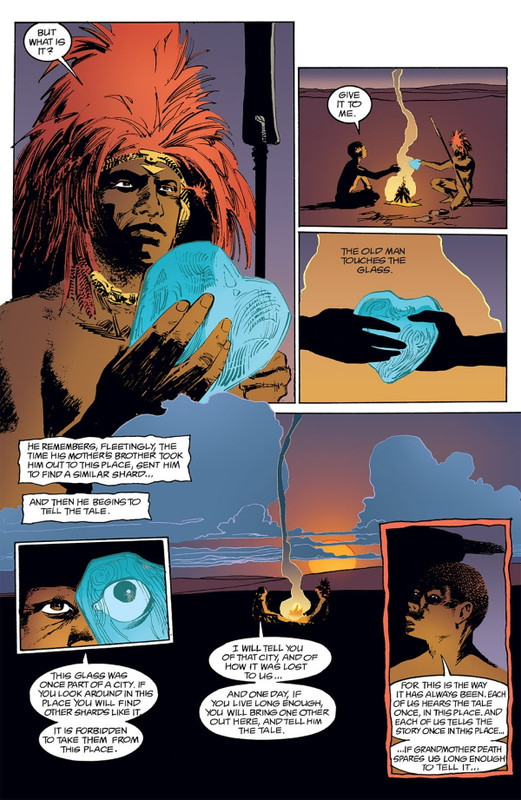 There are a few striking things about this chapter which I want to mention: Firstly, Gaiman paints Morpheus – who is nominally the series' central protagonist – in a somewhat less than flattering light here. The author depicts Dream as a capricious and rather spiteful being, who threatens Nada with "eternal pain" when she spurns him, and he eventually banishes her to Hell. It's a testament to Gaiman's skill as a writer that this somewhat unusual characterisation for the "hero" doesn't diminish the reader's respect or affection for Morpheus: it only strengthens it, by showing us that despite being a demigod, Dream is fallible and susceptible to moments of cruelty, much like the various gods in Greek mythology and their dealings with mortals. Secondly, I think the most intriguing thing about Nada's tale is that the tribal elder who recounts the story states that there are two versions of it – one that the men folk tell, and one that the women folk tell. Obviously, we only get to hear the men's version of the story, since it's a man in the book who recounts it to another male. But I couldn't help thinking that Gaiman was – on an entirely meta level – making some kind of comment on the predominantly male readership of comic books (especially back in the early 1990s). What I mean by that is that it's like the The Sandman book assumes that the reader will also be a male. I dunno, maybe I'm over-thinking things. The third point I want to make is that this chapter is a total change of pace for The Sandman and like nothing that has come before it, stylistically or narratively. However, it's not a clunky, gear-grinding change of pace at all; it still feels like a Sandman story...and it also feels like a very authentic piece of African folklore (even though it's not). Gaiman, it seems, is determined to forge a comic series that can take the reader anywhere and tell any kind of story – in this case, a story within a story – and still have it sit comfortably within the confines of The Sandman's over-arching narrative. Having already shown us Dream and Death in the last volume, Gaiman here introduces us to two more of The Endless family, Desire and Despair. Desire dwells in a huge, human-shaped fortress called the Threshold, and seems to be androgynous or non-gendered... 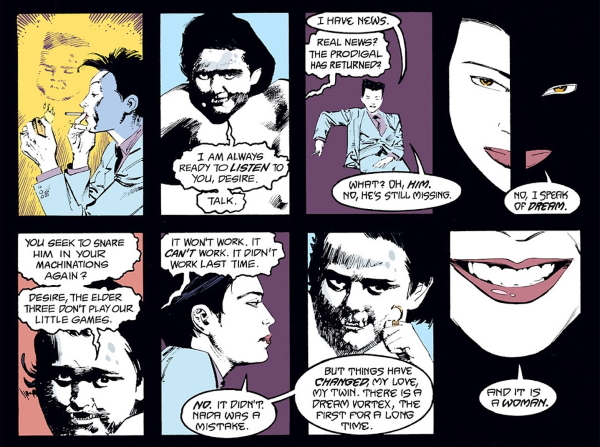 As you can see from the panels above, we learn that Desire played a role in Morpheus and Nada's doomed love affair, and is clearly laying a trap for his/her brother, although we the readers aren't quite sure what he/she is up to yet. The main thrust of the story in "The Doll's House" concerns a young lady named Rose Walker, who we learn is a dream "vortex", which means that her existence erodes the barriers between dreams and threatens to destroy the minds of all dreamers. Along the way, we meet the bizarre inhabitants of a lodging house where Rose is living: there's the seemingly perfect couple Ken and Barbie (heh! It's a doll's house, geddit?), the latter of whom we shall meet again in the series; Chantel and Zelda, two weird, spider-obsessed women in white gowns; and a rather rotund gentleman in late middle-age, named Gilbert, who attempts to look out for Rose's well-being. It turns out later that Gilbert is actually Fiddler's Green, a region of Morpheus's realm, the Dreaming, which has taken on human form. Morpheus must kill Rose, or else every dreamer will be destroyed by her. However, Rose was never supposed to be a vortex: that was supposed to be her grandmother, Unity Kincaid, who was asleep for decades, as a result of Dream having been imprisoned by the occultist Roderick Burgess. This was partly explained in "Preludes & Nocturnes", as was her rape and subsequent pregnancy, which resulted in Rose's mother being born. What wasn't explained, but which we find out here, is that Unity was raped by Desire, which makes Rose the granddaughter of one of the Endless. For that reason she cannot be killed by Morpheus, without dire consequences. In the end, Morpheus spares her, with help from Fiddler's Green, but I won't spoil exactly what occurs, as it's a rather lovely ending to the book. We also find out in this volume that Morpheus doesn't perpetually look like a pale, spiky-haired goth – that's just his then-current (i.e. early '90s) look. He changes his appearance to fit whatever era he happens to be manifesting in, as illustrated in the "Men of Good Fortune" interlude, in which we see Morpheus visit a number of different decades, in order to meet up with a human who he has granted immortality to, Hob Gadling... 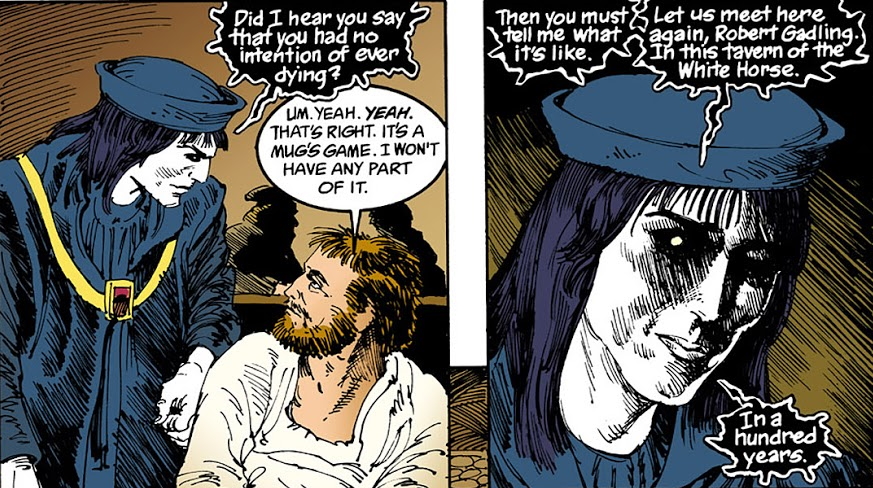  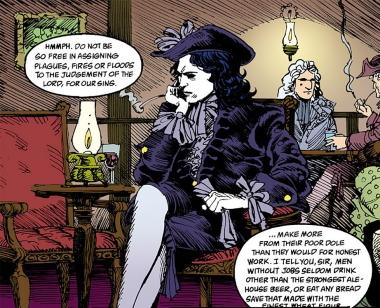 The "Men of Good Fortune" chapter is drawn by Michael Zulli, rather than Mike Dringenberg, and I must say that I like his art a lot. It's a particularly good fit for the 15th century setting at the start of this chapter... 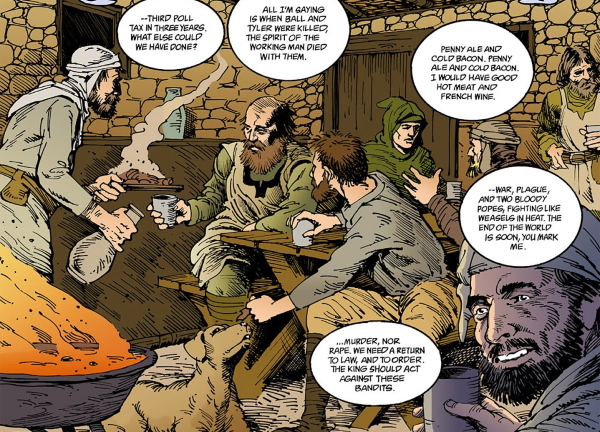 By the way, I love the then-topical reference to the poll tax in the above panel. Margaret Thatcher's Conservative government tried to introduce the poll tax in Britain in 1990, ostensibly as a way to save the rich money, by moving the burden of raising local council revenue to the poor. The proposed tax proved highly controversial and resulted in widespread protests and civil disobedience in 1989 and 1990 (known as the poll tax riots). Gaiman must surely be referencing the similarities between late 15th century and late 20th century British politics here. Anyway, Gadling and Dream arrange to meet every hundred years, starting in 1489 and going all the way up to 1989, which, of course, was the present day when this particular issue came out. Along the way, Gaiman playfully drops in cameos of literary figures like Chaucer and William Shakespeare, with Dream striking a bargain with the latter, which we will see the fruits of in volume 3, "Dream Country". Gaiman is also still trying to shoehorn elements of DC's superhero continuity into The Sandman, which, while I understand his rationale for doing so, I really wish he wouldn't. In issue #12 we meet Brute and Glob, two nightmares created by Morpheus, who have created a fantasy dream world, with the colourful Bronze Age DC superhero Sandman as its unsuspecting centrepiece... 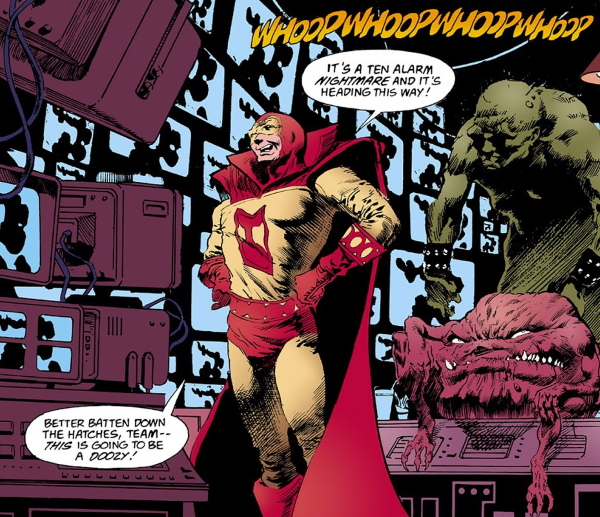 Personally, I know little or nothing about this Kirby and Simon-created Sandman, and I can't help feeling that I'm missing something with these appearances of DC Comics characters. I have a sneaking suspicion that, if I was better versed in obscure DC continuity, I would get much more out of these episodes. If so, I consider that something of a failing on Gaiman's part as a writer. We also meet the Bronze-Age Sandman's wife, Lyta, who has been pregnant for many years, without ever giving birth. It turns out that Sandman is actually dead and has been living in Brute and Glob's dream world on borrowed time. Morpheus releases him, which effectively means he ceases to exist in any form, leaving Lyta angry and grieving. Morpheus then enigmatically tells the expectant mother, " The child you have carried so long in dreams. That child is mine. Take good care of it. One day I will come for it." This, I assume, is something that will be revisited in future instalments of the series. Morpheus himself plays a much smaller part in "The Doll's House" than he does in the previous volume. Gaiman instead focuses on the journey of Rose Walker through America in search of her brother, Jed – and there's a nice Little Nemo homage in the depictions of her brother's dreams. Along the way, Rose encounters a cereal convention – which is actually a cover for a serial killer's convention! While this provides plenty of dark humour and is an entertaining set piece, it does seem like another bit of slightly immature, oh-so-edgy, so-called "adult" writing on the author's part, much like the diner sequence in "Preludes & Nocturnes". Actually, the serial killer's convention is as good a point as any to talk about the horror elements present in The Sandman, which badwolf, codystarbuck, and beccabear67 mentioned earlier. Myself, I really don't consider the series to be a horror comic at all, which is something that I have seen it described as online. It has horror underpinnings, for sure, but overall it's much closer to dark fantasy or something. I mean, clearly it's not horror in the way that The Exorcist, The Evil Dead, or even the somewhat thematically similar Nightmare on Elm Street films are. But neither is it horror in the more cerebral and fantasy/sci-fi based mould of H. P. Lovecraft. I suppose I consider The Sandman a fantasy comic first and foremost, with an undercurrent of horror and moments of the horrifically violent sprinkled throughout. Summing up, I enjoyed "The Doll's House" quite a lot, although their were definitely parts of "Preludes & Nocturnes" that I enjoyed more. In particular, the whole "Rose is a dream vortex" thing was a bit much for my tastes. It seemed to me to be one of those, over the top, "the hero's got to stop this or it will destroy THE WHOLE UNIVERSE!!!" type of things. It was just a touch too comic-booky for The Sandman, I felt. Still, I'm very much hooked on the story, and I'm eager to begin reading volume 3. Gaiman seems to be setting up a lot of stuff for future story arcs in "The Doll's House" and I'm interested to see how it all works out and comes together. So yeah, volume 2 of The Sandman is a good read, but, for me at least, the series still hasn't really delivered anything to justify its towering reputation. Hopefully, it will before long.
|
|
Confessor
CCF Mod Squad
Not Bucky O'Hare!
Posts: 10,974 
|
Post by Confessor on Dec 3, 2019 14:49:40 GMT -5
OLD REPLIES TO VOLUME 2:Here is the discussion that Slam_Bradley and I had about my original short review of "The Doll's House", over in the "What classic comics have you read lately?" thread... On August 22nd, 2019 Slam_Bradley wrote: To which I replied... One thing to keep in mind is that those books that became a part of the first Vertigo imprint (Sandman, Hellblazer, Animal Man, Doom Patrol, Swamp Thing) were all intimately connected to the DCU. One of the earliest ads for the incipient imprint described it as a place to explore the dark weird corners of the DC Universe. So Gaiman felt like the needed to deal with the various Sandmans (Sandmen?) that went before. Ah, I see. OK, that makes a lot of sense. The appearances of various minor DC characters does seem out of place to me, but this at least justifies it somewhat. You're absolutely right that both Lyta and the unborn child will become very important later on. I thought so. I look forward to seeing how this story thread progresses. Jed Walker, Rose's brother, was the Garrett Sandford Sandman's sidekick. Right, I had no idea, but that makes sense too, given the red-and-yellow Sandman's appearances in Jed's "Little Nemo-esque" dream sequences. So much to love in this storyline. Hob Gadling and Morpheus' meetings. The Cereal Convention. Nada's tale. Fiddler's Green. Slam then replied... I don't want to spoil anything...and I don't think that I will. Gaiman tended to write arcs in the book that were more male-oriented and ones that were more female-oriented. For example "A Game of You" is considered to be a female arc while "Seasons of the Mist" is a male arc. I'm not sure that Gaiman necessarily planned it that way (I just can't recall at this point) but that's the response from fandom and critics. Sandman, as a comic, had what would be considered a large female following for the time. It was also one of the first comics that really took off in collected editions and thus with a broader audience than the "Wednesday Warriors" contingent. I do think that Gaiman tended, even from the get-go, to write stronger female characters than most of his peers, though I know that he would admit that he was not without fault in a number of his characters over the years.
|
|
|
|
Post by beccabear67 on Dec 3, 2019 15:16:40 GMT -5
I wonder if we could call the years 1986-1996 The Dark Ages for comic books? Maybe the seeds were Frank Miller on Daredevil and the dark Phoenix X-Men story, but starting around 1986 things got dark and 'mature' in the worlds of super people. I'm a bit skeptical about the 'females like stories where they are orphans that are really princesses' line, but I read books like Heidi, The Secret Garden, The Little Princess, Alice, Jane Eyre and Anne Of Green Gables which all have at least an aspect of that. I don't think Little House On The Prairie or Charlotte's Web did though, and I liked them as much or more. American authors whereas the others all were non-U.S. Hmmm.
|
|
